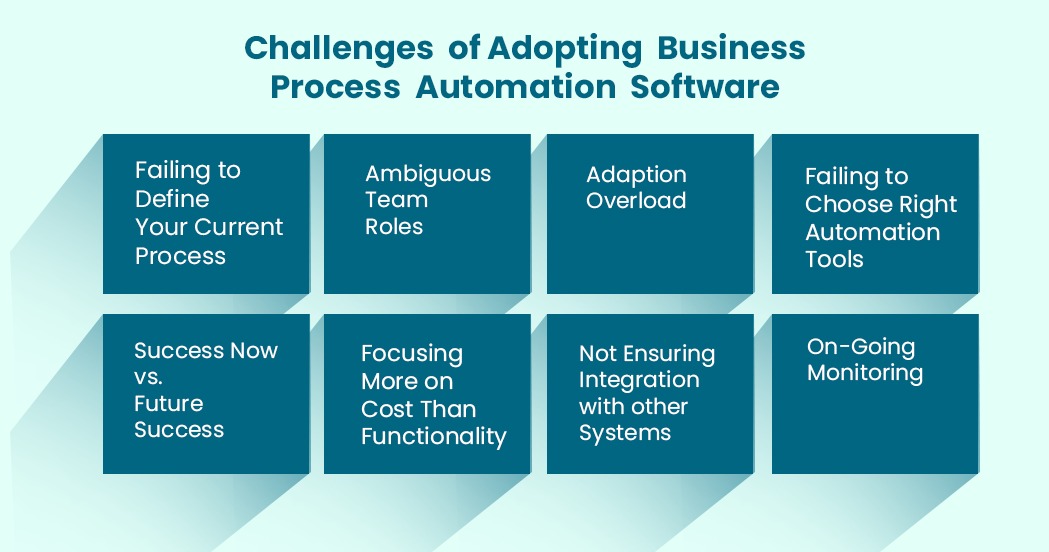
Gartner has identified hyperautomation software as the fastest-growing category, saying that it is integral to business survival. By 2022, 72% of Fortune 100 companies will have implemented business process automation and by 2027, 100% of businesses in this top bracket would have implemented digital process automation (DPA). Other businesses will have to follow suit as every company tries to improve its cost efficiency.
Hyperautomation is a business approach method to identify as many processes as possible that can be automated using technology such as robotic process automation(RPA), AI and virtual assistants built on low-code application platforms (LCAP)
Automation, though, is not without its inherent challenges and pitfalls. The devil is really in the details, with minute details having the potential to cause a cascading negative impact.
Here are some of the reasons why business process automation can sometimes go wrong for businesses.

1. Failing to define clear automation goals
Visualize the end of your automation project.
Automation is good for business growth so you may expect that deploying automation in as many business processes can make perfect business sense. Unfortunately, that theory doesn’t hold good. You need to work out an automation strategy to ensure that business process automation does not go wrong
You have a vision document for your organization, similarly, you should have a clearly defined automation strategy worked out to define your automation goals.
Identify the areas that are most likely to benefit from automation. Areas that involve repetitive functions, such as routing purchase orders or customer queries, accounts payable processing, generating reports, customer support calls etc. This would be better than going for a sweeping overarching automation exercise throughout the organization.
2. Failing to pick the right tools
It’s vital to focus on the automation of the right processes using the right tools.Don’t waste time on software that does not exactly fit your business needs. To make the right decision, find out the automation software successfully used by other companies in the industry you operate in and use demos and free trials of software to help you decide. Often companies try to fit their automation process around the tool. Rather, it is important to pair the right business activity with the right tools.
Before evaluating tools, if your company is just starting out to automate tasks, it is important to first start small. First, pinpoint the most suitable process to begin your company’s automation journey.
Gartner recommends automating tasks with the lowest risk and highest volume of work.
Automating most of the processes could not only be a costly exercise but could even leave your employees confused and your customers dissatisfied. If a task needs a human touch, best leave it to a human, instead of implementing a blanket automation of all processes.
Also read : Robotic Process Automation vs Traditional Automation
3. Failing to design the automation process around the people who will use it
It is true that as workplaces get digitized and workforces get younger, businesses and staff are more open to technology taking over monotonous low-level functions.
A recent Mckinsey survey found that 7 out of 10 workers believe adopting automation in their organization will create better opportunities for them in higher-skilled jobs.
However, it is also true that one of the biggest problems of automation is that staff begin to worry that their jobs will be replaced by technology. Your organization will need to do a repurposing exercise to identify new ways in which your employees can be utilized to add value to the company. Employees need to know in advance how technology will improve the organization and how their skills will be utilized after automation.
Early in the automation process, make sure to clearly and sensitively communicate to the workforce that automation of the tasks hitherto done by them, would mean better growth opportunities for them within the organization.
We also need to remember that business process automation is not intelligent – it will do what it is told to do. Automation cannot think out-of-the-box, deal with complex or unique problems. After all, human initiative and understanding remains the core of a successful business.
Also read : Why Embracing Intelligent Automation Will Change the Way We Work
4. Failure to evaluate how automation tools will integrate with existing tech stack
This is a big one when it comes to mistakes in automation. Your tech team must make sure that automation tools can be easily integrated with the existing technology platforms. For instance, if you are automating your Customer Help Desk and then find that it is not compatible with your CRM, it can be a huge mistake.
While evaluating automation software, make sure how it will easily integrate with your tech stack. If it cannot be integrated directly, it might require additional infrastructure in the form of an IPaas (integration platform as a service).
5. Failing to use automation maturity assessment and testing at appropriate levels
Automation maturity assessment helps businesses know where they stand, where they need to get to and how they can increase productivity with each progressing level of automation maturity.
Failing to realistically gauge their true level of automation maturity as they begin the automation process could make businesses set automation goals that are too aggressive or too low-key. So a successful strategy requires a clear-cut assessment about understanding of your business and customers are ready for the level of automation you are seeking to implement.
Automation assessment must also consider customers and how acceptable they are to change . For instance, if chatbots are implemented, will customers accept it? Collecting feedback from customers before implementation and keeping them informed in advance might be important steps to gain customer acceptance. A more gradual rollout is recommended in customer-facing business process automation.
Finally, intelligent automation brings many benefits in cost efficiency and productivity improvements but it cannot happen overnight and enough time must be spent on research. Partnering with a technology partner experienced in business process automation can help you avoid many of the hurdles on the way to operation excellence.










